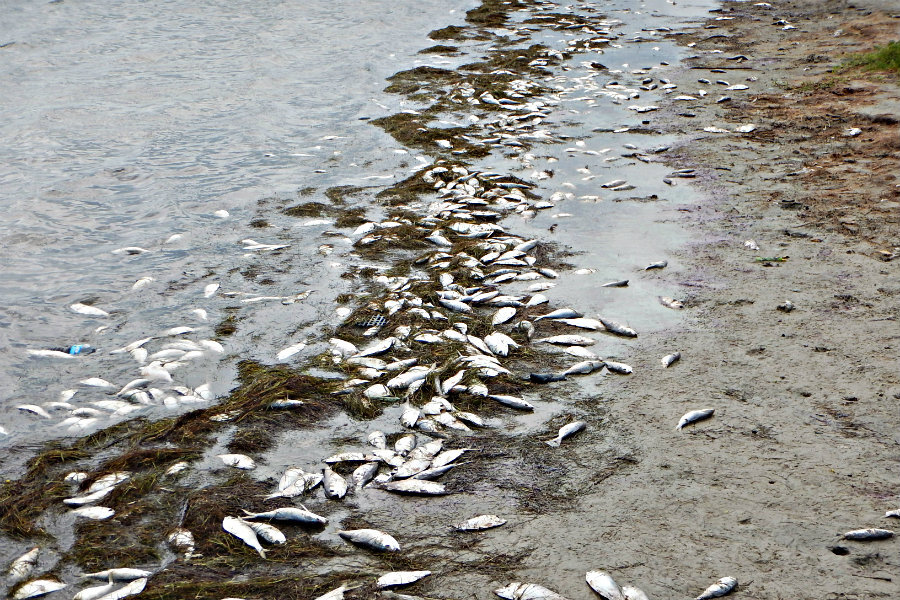Why did thousands of fish die in New Jersey?
Loading...
Keansburg, N.J., residents might just have to hold their noses over the next few days, after a plague of small, dead fish descended upon the local marina.
The dead fish have choked the marina, cutting off access to dozens of boaters, whose engines are too surrounded by stinking dead fish to move.
“What’s happening in people’s back yards in New Jersey is a symptom of a broader social challenge,” Doug Rader, the chief oceans scientist for the Environmental Defense Fund, tells The Christian Science Monitor. “Large fish kills are often a sign that more needs to be done to restore water quality in estuaries. It is a normal occurrence, but it is exacerbated by human impact.”
Others disagree, however.
“It’s nature being nature,” New Jersey Department of Environmental Protection spokesperson Lawrence Hanja tells the Monitor. “These events have happened over the centuries and will continue to happen. It’s just part of how nature works and the ecosystem maintains equilibrium.”
The fish are a variety called the juvenile Atlantic menhaden, commonly known as the peanut bunker, a small three- to four-inch long fish that serves as the main food source for many game fish.
Experts say that the massive school of fish was likely chased into the marina by bluefish or skates from a larger local bay. The die-offs were then caused by low oxygen levels in the marina.
“Bunker, or menhaden, are an integral part of the food chain. They’re very bountiful,” says Mr. Hajna, who adds that when a large school of these little fish find their way into a small marina, it is very easy for them to deplete the oxygen in the water.
These problems are exacerbated by higher water temperatures: colder water holds oxygen better than warmer water does, meaning that by mid-August, the Keansburg marina was primed for such an event. Experts say that this could mean that fish kills will get worse as climate change advances.
“That pattern will be exacerbated as waters continue to warm on the East Coast,” Dr. Rader told the Monitor. “For animals that are vulnerable to low oxygen levels, that makes things worse. I don’t know if this particular fish kill was caused by global warming, but this problem will be more frequent and worse as waters continue to warm along the East Coast.”
Rader also tells the Monitor that fish kills are often just one symptom of an ecosystem struggling with a greater environmental problem, such as elevated nitrogen levels that contribute to algal blooms, among others. According to Rader, the Hudson-Raritan watershed has been the subject of a number of environmental efforts in recent years, which have greatly improved ecosystem health in the watershed.
Although somewhat shocking, die-offs like Keansburg’s are not unusual. In 2010, New Jersey’s Delaware Bay saw an even larger die-off, with around a million dead peanut bunkers washing up on nine miles of coastline.
Unlike planned fish killing events, such as Yellowstone’s planned stream cleansing later this summer, the Keansburg die-off was not a response to a larger invasive species problem, and will have little to no effect on local fish species, according to Hanja.
Locals say that the fish aren’t just cluttering up the marina and making it difficult for boat owners to go about their days. They are also making life miserable for anybody who has to breathe in the area.
“It’s bad, it’s enough to gag you,” a resident told CBS2. “It smells like a sewer plant backed up and let out in the water.”
While conditions may be miserable at the moment, local officials say that they are doing all they can to clean up the mess. Keansburg public works employees hope to finish most of the cleanup efforts by the end of today.
“Right behind us in the creek we really can’t do much about it because it would be a massive clean-up effort,” Keansburg mayor George Hoff told CBS2, “but on our beach where they washed up, our Department of Public Works is taking care of it.”








